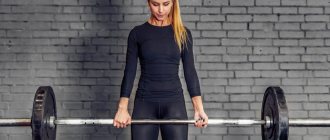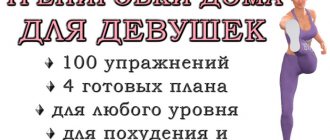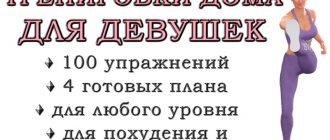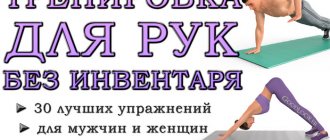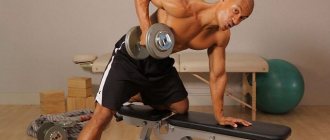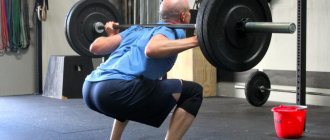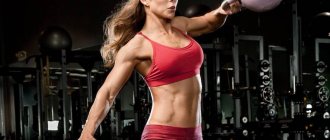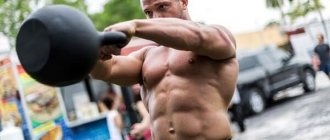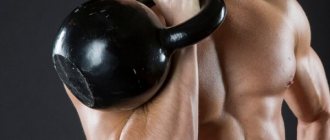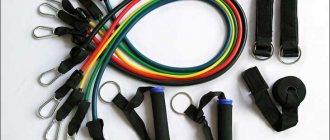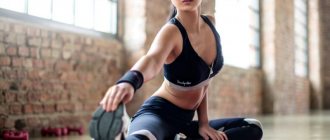Exercises with free weights are the basis for building a beautiful and strong body. Strength training with dumbbells and barbells is useful for both men and women, as it strengthens muscles, develops physical strength and forms an athletic profile.
We offer you a selection of the best barbell exercises that will make your free weight training high-quality and effective.
Basic exercises with a barbell
Basic multi-joint exercises are the basis of strength training, as they involve the maximum number of muscle groups, increasing the strength and endurance of the body. This section contains exercises with a barbell for effectively working out the entire body.
We recommend watching:
- Top 100 exercises with dumbbells for women
- Top 60 dumbbell exercises for men
Squats
What Muscles Work: This basic barbell exercise works the lower body musculature, as well as the abs and psoas. The main load is received by the quadriceps, buttocks, hamstrings, back extensors and calf muscles.
What the exercise does: Squats with weights strengthen the muscles of the core and lower body, as well as the joint-ligamentous apparatus, increase the strength and endurance of the body, improve balance and coordination of movements, and form a beautiful relief of the legs and buttocks.
How to do it correctly: If you train in the gym, then this exercise with a barbell is best performed in a power rack. Place the bar on the trapezius area. Place your heels on the floor and begin squatting. The chin is raised, the shoulders are turned, the back is straight. Move your pelvis as far back as possible without bending at the waist. Squat until parallel to the floor, making sure your toes are level with your knees. Don't tuck your pelvis as you lift, and keep your knees slightly bent to reduce stress on them.
Deadlift
What Muscles Are Worked: Another basic barbell exercise from the weightlifting set that works the lower body as well as the back muscles. Most of the load falls on the latissimus, rhomboids, trapezius, spinal extensors, as well as the biceps and quadriceps of the thighs, and the gluteal muscles.
What the exercise does: Being a multi-joint exercise, the deadlift strengthens the back, legs, buttocks and core muscles, promotes the development of strength, and the formation of athletic relief. Deadlifts also strengthen the deep stabilizer muscles of the spine, creating correct posture and relieving back pain.
How to perform it correctly: The barbell in this exercise is taken from the floor with a straight or mixed grip. Once you are as close to the barbell as possible, bend your knees and bend over with your back straight to grab the barbell from the floor. Shoulders should be turned, chin raised. Raise the bar by straightening your legs, but do not lean back. Pull the bar up to hip level without straightening your knees completely, and then lower it to the floor by bending your knees and leaning forward.
Barbell deadlift
What Muscles Are Worked: The straight-legged deadlift variation works the spinal stabilizers and extensors to a greater extent, as well as the core, hamstrings, and glutes.
What the exercise does: The deadlift (Romanian) is more suitable for women than the deadlift, as it forms the relief of the back of the thighs and tightens the buttocks. But it is also recommended for men to perform deadlifts to strengthen the lower back and legs. Additionally, this barbell exercise strengthens your core muscles, including your abs.
How to do it correctly: To do this, take the barbell with an overhand grip, place your feet shoulder-width apart, and bend your knees slightly. Now lean forward with a straight back, you can bend a little at the lower back. Lower the bar to the level of your shins; do not bend too low. During the exercise, you should feel the muscles in the back of your thighs stretch.
Lunges in place with a barbell
What muscles are involved: Lunges in any variation are considered an effective basic exercise with a barbell. Standing lunges work your glutes, biceps, quads, calves, core, and abs.
What the exercise does: The classic barbell exercise helps pump up your buttocks, strengthen your legs, and increase overall body strength, coordination and balance.
How to do it correctly: You can perform lunges in place with a free barbell in a power rack or in a Smith machine with a fixed bar. To perform, place the barbell on your shoulders and take a wide step back. Then bend your knees, lowering into a lunge. Squat until your front thigh is parallel to the floor and make sure your knee does not extend beyond your toe. Throughout the exercise, keep your back straight and your shoulders turned. Don't forget to repeat the lunges on the other leg.
Bench press
What muscles are involved: The basic barbell exercise from weightlifting triathlon is aimed at developing the pectoral muscles. During the bench press, the pectoralis major and minor muscles work, as well as the triceps and anterior deltoids.
What the exercise does: The exercise develops the upper body, increasing the strength of the arms and shoulders, and also forms relief in the chest area. In addition, the bench press helps stretch the pecs, which increases their elasticity and potential for growth.
How to do it correctly: The bench press is performed on a straight or incline bench with bar racks. To perform, lie on a bench and grab the bar with a straight, closed grip. The distance between your palms should be slightly wider than your shoulders. Lower the barbell to your chest, spreading your elbows out to the sides until they are parallel to the floor. Then press the bar up, straightening your arms. During the press, your elbows should be bent at right angles and pointing out to the sides, not down.
Belt pull
What muscles are involved: The exercise develops the back muscles, in particular the latissimus, trapezius and rhomboids, and also connects the front deltoids and even the upper pectorals.
What the exercise does: As a basic exercise with a barbell, the waist row develops overall body strength, pumping up all the large muscle groups of the back, and also strengthens the arms, shoulders and chest.
How to do it correctly: Before performing the exercise, place the bar on a rack in front of you, and then grab the barbell with an overhand grip. Bend your knees and lean forward, tilting your back. Lift your chin and bend your back slightly. Now bend your elbows, pulling the barbell towards your waist. The elbows should move straight back and bend at a right angle. Then straighten your arms, returning to the starting position and repeat the movement again.
Army press
What Muscles Are Worked: The standing barbell chest press or military press develops the shoulders, specifically targeting the anterior deltoids and trapezius, as well as the upper pecs, serratus core, and biceps.
What the exercise does: The classic barbell exercise helps build mass in the shoulder area, strengthens the shoulder joints, increasing their stability. At the same time, the military press improves flexibility and mobility of the joints, which prevents injuries in this area.
How to do it correctly: To do it, take the barbell with an overhand grip and bend your elbows, placing it on your shoulders in front of you. Stand straight, shoulders back, chin raised. Press the barbell up overhead, keeping your elbows slightly bent, then press back down. During the press, do not help yourself with your body, it should be stable, only your arms and shoulders work. At the lowest point, bring your shoulder blades together for maximum load.
You can perform exercises while sitting for a more isolated load:
Chin pull
What muscles are involved: A basic exercise with a barbell will help you pump up the trapezius muscles of the back, deltoids, and also strengthen your arms, in particular your biceps and forearms.
What the exercise does: The exercise develops the muscles of the shoulder girdle, forming relief in the upper body, strengthens the back and arms, and contributes to the development of overall body strength.
How to do it correctly: To perform a chin-up correctly, grab a barbell with an overhand grip and lower your arms down. Now pull the bar up, bending your elbows and spreading them to the sides. At the top point, the elbows form an acute angle as they rise upward. Pull the barbell to shoulder level and then lower it down. The projectile should “slide” along the body, moving in one plane.
Barbell Curl
What Muscles Work: The key goal of this barbell exercise is to work the biceps, but in a standing position it also works the core stabilizers, shoulders, and small muscles of the forearms.
What the exercise does: Biceps curls will help you increase the volume of your arms and strengthen your shoulder girdle. In addition, exercise improves blood circulation in the upper body and stimulates metabolism.
How to do it correctly: To do it, take the barbell with a reverse grip and lower your straight arms down, bending them slightly at the elbows. Now bend your arms with full amplitude, bringing the barbell to your chest. Keep your elbows slightly bent at the bottom to help prevent injury. Perform the exercise slowly without sudden movements, focusing on flexing your biceps.
French bench press
What muscles are involved: An isolated exercise for pumping up the triceps, which provides a load to all three bundles of the largest muscle of the arm.
What the exercise does: The French press promotes mass gain in the upper arms, forming an impressive profile. The exercise also strengthens the joints, improving their mobility and stabilizing them through muscle growth.
How to do it correctly: To perform the exercise, take the bar with an overhand grip and lie down on a straight bench without racks. Lift the barbell above you and bend your elbows, lowering the bar behind your head. Do not bend your elbows more than 90 degrees to avoid injuring your shoulders. Perform the exercise carefully at a slow pace, focusing on working the back of your arms. Not only a straight bar, but also a Z-bar is suitable for this exercise.
Weight selection
This is a mandatory procedure that precedes any exercise with a barbell. It is extremely important to correctly determine this parameter, otherwise it will not be possible to achieve a positive result in building muscle mass; this is done exclusively through trials and experiments.
To successfully implement this process, the following tips can be given:
- To begin with , set the average weight, for men it is about 40-50 kg, for women 20-25 kg, for beginners it is best to focus on your feelings.
- Try basic exercises; to increase muscle mass, it usually takes from 6 to 12 repetitions; if the selected weight does not allow you to do them, then it must be reduced.
- If after 12 repetitions it is still possible to perform further exercises, and the muscles are not tired at all, then you can try to increase the weight by another 10 kg, since the established load will not be enough for muscle growth.
Additional exercises with a barbell
Below are basic and isolating exercises with a barbell aimed at targeting specific muscle groups or muscles of the whole body. They allow you to diversify your training and provide stress, including to underused muscles. In this section you will find variations of squats, lunges, rows and presses that will help you deeply work on problem and lagging areas.
Sumo squats
What muscles are involved: A variation of the classic squat, sumo works the adductors of the hips and buttocks, and also engages the quadriceps, back stabilizers and quadratus lumbar muscles.
What the exercise does: Sumo is considered a basic barbell exercise for girls, as it provides targeted load on the buttocks and works the inner thighs, tightening the legs and making them slimmer. Sumo squats can also be performed by men to diversify the workout and involve more muscles in the work.
How to do it correctly: In the gym, sumo squats with a barbell are performed in a power rack, like other types of squats. Place the bar on the trapezius area. Then step back a few steps and place your feet wider than shoulder-width apart, pointing your toes out to the sides. Now squat, moving your pelvis back until your thighs are parallel to the floor. Remember to keep your back straight and squeeze your shoulder blades together.
Front Squats
What Muscles Work: This variation of squats places additional weight in the front, which increases the load on the front of the body, particularly the quadriceps and abs, while reducing the load on the knees and back.
What the exercise does: These squats promote quadriceps growth, loading them more than classic squats, and increase the load on the core, thereby improving spinal stability. With front squats, the impact on the knees and spine is reduced, but the buttocks also receive less stress.
How to do it correctly: To perform it, take the bar with an overhand grip and place it on your shoulders in front of you, bending your wrists. From this position, bend your knees to perform squats. Pull your pelvis back until it is parallel to the floor, while maintaining a slight arch in your lower back. Keep your shoulders straight and keep your chin raised. When rising from a squat, do not fully extend your knees, which will help protect them from excessive stress.
Sumo deadlift
What muscles are involved: The sumo deadlift, as in the case of the squats of the same name, uses the adductor muscles to a greater extent, which take on part of the load of the hamstrings. The core, abs and buttocks are also involved.
What the exercise does: The sumo deadlift allows the athlete to take more weight than in the classic deadlift, since the range of motion of the back is shorter here. In addition, the sumo deadlift develops the flexibility of the legs and strengthens their inner surface, which is especially suitable for girls.
How to do it correctly: Before performing, stand close to the barbell that lies on the floor in front of you. Place your feet as wide as possible and bend your knees as you lower yourself into a sumo squat. Bend over with a straight back and grab the bar with an overhand grip, then straighten your legs, lifting the barbell to hip level. Then bend your knees again, lowering the projectile down. At the same time, maintain a slight arch in your back and do not squeeze your shoulders. At the top point, do not lean back so as not to load your lower back.
Lunges forward
What muscles are involved: A basic barbell exercise that deeply works the gluteal muscles, hamstrings, quads and calves, lower back muscles, spinal stabilizers, core and abdominals.
What the exercise does: Lunges forward provide targeted load on the buttocks, contributing to the formation of relief in this area. The exercise also strengthens the legs and abs, including the oblique muscles, and increases the overall strength and endurance of the body. Improves balance and coordination.
How to do it correctly: To do this, place a barbell on your shoulders and stand straight with your feet shoulder-width apart. Take a long step forward and bend your knees to lower into a lunge. Using your gluteal and thigh muscles, come back and repeat with the other leg. When performing the exercise, make sure that your legs are bent at a right angle, which will provide stability to the knee joints.
Back lunges
What muscles are involved: This barbell exercise primarily works the glutes and hamstrings, followed by the quadriceps. The calves, back stabilizers, and abdominal muscles, including the obliques, also work.
What the exercise does: The lunge variety uses the buttocks more, unloading the hips, and therefore is more often used in women's training. Back lunges will help you round out your butt and sculpt your hips, as well as strengthen your abs and core. In addition, when performing backward lunges, less stress is placed on the knee joints.
How to do it correctly: To perform back lunges, place a barbell on your shoulders and stand straight with your feet shoulder-width apart. Now take a long step back and bend your knees. Make sure your front knee does not extend beyond your toes. Using your glutes, return to the starting position and repeat the lunge with the other leg.
Bulgarian split squats
What muscles are involved: The exercise actively involves the gluteal muscles, quadriceps and hamstrings, as well as the calves. Additionally, the oblique and rectus abdominis muscles and spinal stabilizers work.
What the exercise does: In Bulgarian split squats, each leg is loaded in turn, which allows you to work the muscles of the thighs and buttocks more deeply. This barbell exercise uses all the small and large muscles of the buttocks, making them rounder and fuller.
How to do it correctly: For the exercise you will need a knee-high straight bench and a barbell. Place the bar on your shoulders and stand with your back to the bench at a distance of one step. Place one foot on the bench with your arch down. Now bend your front leg at the knee until it is parallel to the floor. Make sure that your knee does not bend at an acute angle. Once you've completed all the reps on one leg, do split squats on the other.
Reverse grip row to the waist
What muscles are involved: An auxiliary exercise with a barbell for working out the back actively engages the arms, especially the biceps and the muscles of the inner forearms. All other muscles work in the same way as in the classic version: first of all, the latissimus, trapezius, rhomboid and teres muscles are involved, and then the back extensors, rear deltoids and lower back muscles.
What the exercise does: The reverse grip row is included in the training plan for variety or if you need to focus on working your arms, because the biceps work here to a greater extent than in the classic row to the waist.
How to do it correctly: To perform it, take the bar with a reverse grip and place your feet shoulder-width apart. Bend your knees slightly and tilt your back forward, arching your lower back. Squeeze your shoulder blades and bend your elbows, pulling the barbell toward your waist. Then straighten your arms, returning to the starting position.
Close grip chest press
What muscles are involved: The exercise provides an intense load on the triceps, in addition to pumping up the pectoral muscles and anterior deltoids.
What the exercise does: At its core, the close-grip chest press is a utility exercise for increasing arm and upper body strength. The exercise stimulates the growth of the triceps, which determines the volume of the upper arms. The lower the barbell goes to the chest, the higher the load on the triceps.
How to do it correctly: Perform the bench press with a narrow grip on an inclined or straight bench with less weight than in the classical technique. To perform this, lie on the bench and take the bar from the racks with an overhand grip, placing your palms on the bar narrower than shoulder width. The position should not be too narrow; a distance of at least 20-30 cm should be maintained between the palms. Next, perform the bench press using the classic technique, lowering the barbell as low as possible to the chest. In this case, the elbows do not spread to the sides, but go slightly forward, forming an acute angle between the shoulder and forearm.
Bench press
What muscles are used: The overhead press is considered an effective barbell exercise for training the shoulders. The exercise works the middle fascicles of the deltoids, which form the relief of the shoulders. The trapezius and triceps are also involved.
What the exercise does: First of all, the exercise works the shoulders, giving them a voluminous shape, thanks to the emphasis on the middle beam of deltas. In addition, the overhead press strengthens your arms and upper back. But it is important to remember that the exercise is traumatic, so it should be performed technically correctly and observing safety measures.
How to do it correctly: To perform it, take the barbell with an overhand grip and lift it up, as in a military press, and then lower it behind your head. From this position, press the bar overhead, lowering it behind the back of your head. At the top point, do not straighten your elbows completely, and at the bottom point, watch the movement of the shoulder joints and do not squeeze the bar to the end, trying to place it on the trapezius. At the lowest point, your elbows should be bent at a right angle, which will ensure your safety during the exercise.
Seated French press
What muscles are involved: A popular exercise with a barbell is aimed at working the triceps in isolation. This exercise also works the small muscles of the forearms and upper pectorals.
What the exercise does: The French press is one of the best exercises for developing powerful arm relief. But it is important to remember about safety precautions, because the exercise is traumatic. Follow the rules of execution and do not try to lift too much weight.
How to do it correctly: The exercise can be performed sitting or standing. Take the barbell with an overhand grip and lift it above your head with straight arms. The elbows should be slightly bent to reduce stress on the joints. Now slowly lower the bar behind your head, bending your elbows. Lower to a right angle between the shoulder and forearm, as too much range of motion can be unsafe. Focus on working your triceps and perform the exercise very slowly.
Bend forward with a barbell
What Muscles Work: The barbell exercise known as a good morning works the same set of muscles as the Romanian deadlift: back extensors, psoas, hamstrings, glutes, core and abdominals.
What the exercise does: Good morninging is used to target the back of the body, including the buttocks, hamstrings, and psoas muscles, which helps strengthen the muscles in this area and form a beautiful definition of the legs and back.
How to do it correctly: To perform, take the barbell from the rack and place it on the trapeze. Place your feet shoulder-width apart and bend your knees slightly. Now lean forward, slightly arching your lower back. Squeeze your shoulder blades to keep your back straight. Bend until your body is parallel to the floor, focusing on the sensations in the back of your thighs. When done correctly, you will feel the stretch in your hamstrings.
Lifting the barbell in front of you
What muscles are involved: An almost isolated exercise for the front and middle deltoids, also affects the upper pectoral and arm muscles.
What the exercise does: Raising your arms will help you strengthen your shoulders and arms. In particular, the exercise helps to work out the front and middle deltoids, which are responsible for the volume and relief of the shoulders.
How to do it correctly: To perform the exercise, grab the bar with an overhand grip and lower your arms down. Remember to bend your elbows slightly so as not to put too much stress on your joints. Now raise your arms up until they are parallel to the floor, using your shoulder muscles to make the movement, not your core or arms. With a controlled movement, lower your arms to the starting position, keeping your muscles tense, and then repeat the rise again.
Shrugs with a barbell
What Muscles Are Worked: An isolated barbell exercise to target the trapezius also works the rhomboids, intercostal muscles, and pectoralis minor.
What the exercise does: The trapezius is the largest back muscle after the latissimus, which has an upper, middle and lower part that reaches the bottom of the ribs. Shrugs affect only the top and middle of the trapezius, strengthening the muscle in isolation, which contributes to the development of strength and relief of the back.
How to do it correctly: To do it, grab the barbell with an overhand grip and lower your arms down. Now raise your shoulders without making any movements with your arms or body. Fix at the top point for 1-2 seconds to enhance the effect. Then lower your shoulders down. Perform the exercise with a full range of motion to increase the load on the target muscle.
Straight Grip Arm Curl
What muscles are involved: The isolated biceps exercise option puts additional stress on the outer forearm muscles, which often stunt growth even in experienced athletes.
What the exercise does: Curling the arms with a barbell with a straight grip allows you to strengthen and develop the muscles of the forearms, pump up the biceps and strengthen the wrist joints.
How to do it correctly: For the exercise, take the barbell with an overhand grip and lower your arms down, bending them slightly at the elbows. Now bend your arms through full range of motion, bringing the barbell toward your chest. During movement, do not bend your wrists, which can be traumatic. Hold the bar with a straight, closed grip and perform the movements slowly and steadily. For this type of curl, take less weight than for classic ones.
Glute bridge with barbell
What Muscles Are Worked: An isolated barbell exercise to target the glutes also works the hamstrings, quads, and core.
What the exercise does: The gluteal bridge promotes the growth of the gluteal muscles, pumping them in isolation, which will help you acquire beautiful relief in this area as quickly as possible. The exercise is safe for the knee joints.
How to do it correctly: To do this you will need a horizontal bench. Lie on the bench with your shoulder blades, bend your knees. Place the bar on the crease of your hips. At the bottom point, you should not touch the floor with your buttocks. Now lift your pelvis up until your body is parallel to the floor. Hold the bar with both hands, do not bend your lower back too much. Perform the movement using the gluteal muscles, not the back muscles. Focus on working the target muscles to maximize the effectiveness of the exercise.
Stepping onto the platform
What muscles are involved: The exercise works the quadriceps, biceps and hip adductors, and also actively engages the calf muscles and strengthens the core.
What the exercise does: By walking with weights, you can strengthen your quadriceps, pump up your biceps and tighten your inner thighs, which is important for girls.
How to do it correctly: For the exercise you will need a horizontal bench or jumping platform that is knee-high or lower. Place the barbell on your shoulders and stand facing the bench. Now step on it with your right foot, following it with your left. Descend on the opposite leg. You can do all the sets on one leg and then the other, or alternate legs as you lift. When stepping, step onto the platform with your full foot. Remember to keep your back straight, shoulders back and chin up.
Calf raise
What muscles are involved: The exercise primarily uses the calf muscles, with minor stress on the buttocks, calves and trapezius.
What the exercise does: Isolation on the calves is needed to achieve beautiful shape of the lower legs, which is not so easy to develop with basic compound exercises.
How to do it correctly: To perform calf raises, you will need a step platform or a small, stable elevation, such as a threshold. Place the barbell on your shoulders and place your toes on the platform. Feet should be shoulder-width apart, back straight, shoulders turned. Lift your heels as you rise onto your toes on the platform, and then come back down. Pause at the top to increase the load. Do not perform the exercise on an unstable support, as this can be dangerous.
Varieties of vultures
We will not list all possible types of barbells, since some of them are considered exotic for most of our gyms. For example, a Hatfield bar or a trap bar.
Let's go through the main varieties that can be found in every fitness club:
- Olympic
This is a classic bar that meets all international sports standards.
Weight, length of the rod and bushings for “pancakes”, diameter, notches - all this and many other parameters are brought to a single international standard.
Its length is 220 cm, weight is 20 kg. The safety factor allows you to safely work with a total weight in the range of 400-500 kg.
- Amateur
There are 2 types of it. The first is very similar to the Olympic one, but with minor deviations in standards. For example, the length and weight are the same, but the diameter is slightly larger. Or a notch is applied according to a different principle.
The second type is also called “folk” or “home”.
It is shorter and lighter. The length ranges from 200 cm to 150 cm (depending on the manufacturer’s imagination). Weight is usually 10-15 kg. Designed for a maximum load of 120-150 kg.
- EZ-neck
Almost every gym has several types of curved bar. These are the EZ bar, W bar and parallel barbell.
They are mainly used for training biceps and triceps, but are also used to pump other muscle groups (for example, the latissimus).
True, they work here with relatively small training weights. Such shells weigh 7-9 kg.
- Powerlifting barbell
There are actually three types of powerlifting bars—all-purpose, squat, and deadlift. The last two are found only in specialized gyms for this sport.
But even a universal one is a rare guest in gyms. It is almost identical in technical characteristics to the Olympic one (length 220 cm, weight 20 kg, diameter of the neck and bushings are the same).
Its main differences from the Olympic bar:
- notches along the entire length
- high degree of rigidity
Capable of withstanding loads of more than 500 kg.
Barbell Exercise Plans
The barbell is a universal apparatus, because one is enough to work the muscles of the whole body. Below are ready-made full body workout plans with barbells for women and men. Select the weight individually; beginners should start with an empty bar.
Full body workout plan with barbell for men
Day 1:
- Bench press: 8-12 reps in 4-5 sets
- Deadlift: 8-12 reps in 4-5 sets
- Forward lunges: 16-20 reps in 4-5 sets
- Lifting the barbell in front of you: 8-12 reps in 4-5 sets
- French press sitting or standing: 8-12 reps in 4-5 sets
- Barbell curls: 8-12 reps in 4-5 sets
Day 2:
- Barbell squats: 8-12 reps in 4-5 sets
- Military press: 8-12 reps in 4-5 sets
- Rows: 8-12 reps in 4-5 sets
- Lunges in place: 8-12 reps in 4-5 sets
- Chin Row: 8-12 reps in 4-5 sets
- Straight grip curls: 8-12 reps in 4-5 sets
Day 3:
- Front squats: 8-12 reps in 4-5 sets
- Close grip bench press: 8-12 reps in 4-5 sets
- Deadlift: 8-12 reps in 4-5 sets
- Reverse grip rows: 8-12 reps in 4-5 sets
- Barbell overhead press: 8-12 reps in 4-5 sets
- French bench press: 8-12 reps in 4-5 sets
A little bit of history
When we hear the word “barbell,” we immediately imagine a long iron stick with weights hanging on the edges.
But once upon a time this word did not exist at all. Today, a barbell means a sports power projectile of variable weight, consisting of a steel axle (bar) and metal plates screwed onto the edges of the axle.
The barbell is different. They differ in the thickness of the neck, the size of the plates, and the fastenings.
The first mention of the similarity of a barbell was noticed in the chronicles of the 16th century AD.
Starting from the 16th century, descriptions of solid and hollow weighting materials began to appear in historical chronicles. The word “solid cast” speaks for itself, but sand or something else (for example, shot) was poured into the hollow ones. The length of the neck at that time was no more than 1 meter.
The first collapsible rod appeared in the 19th century in Germany. And since 1896, the collapsible barbell has become the standard of the Olympic Games. The peculiarity of that rod was that its axis did not rotate.
In the 20th century, they figured out, again in Germany, how to give the bar axial mobility. Now the axis could rotate, and this was invented by a German engineer named Berg.
At that time, discs or pancakes, as they are now commonly called, were exclusively metal and without an external rubber coating.
After 1929, rubber plates appeared, and the barbell became similar to what we know today.
How to reduce the load
You will not be able to gain weight constantly; sooner or later the process will stop. If the working weight does not increase for three workouts in a row, reduce the load as follows:
- Three sets of five reps.
- Three sets of three repetitions.
- One set of three reps and two sets of three reps with -5% of the weight.
You can also reduce the weight by up to 10% of the working weight and add it again, monitoring the technique and correcting your mistakes.
Plateau: what to do when there is no progress
The first thing to do if you fail to complete a set is to rest longer. Place the bar down and wait 5 minutes and then try again.
If it doesn't work this time, check if there are any errors:
- Have not warmed up well: a lack of warm-up approaches forces you to exercise on cold muscles, and an excess of them tires them.
- They did it with bad technology. Incorrect bar trajectory increases the risk of failure.
- Missed training. If you don't load your muscles consistently, you don't grow.
- Did too much cardio or extra exercise, which slowed down your recovery.
- Didn't get enough sleep. Lack of sleep slows recovery.
- We didn't eat. Lack of nutrients also slows down recovery.
If you can't complete all sets and reps for three workouts in a row, you may want to reduce the weight or number of sets and reps.
The Progress Equation: How to Train to Get Results →
Materiel
For working at home, it’s a good idea to have the following items on hand:
- Barbell;
- Dumbbells (there are special kits where two dumbbells are twisted from one barbell);
- Bench bench;
- Partner.
Safety nets are an important component of home workouts. The likelihood of injury is reduced and exercise safety is increased. In addition to purely technical aspects, there are also psychological ones.
It has been proven that working with a partner encourages you to do exercises regularly and forces you to achieve results, without giving you internal relaxation. There is a kind of desire to be first, competition.
Strengthening your back
Exercise 4: Dumbbell Raise
- You will need:
weight bench, 1 dumbbell. - What muscles are worked:
latissimus dorsi, teres major, posterior deltoid (back of the shoulder), radialis brachii. - To do the exercise:
stand next to a bench. Place one knee on the bench. Hold a dumbbell in one hand and rest your other hand on the bench. Tighten your back, then move your elbow back as high as possible and lift the dumbbell. - Breathing:
Inhale while the dumbbell is in the lower position, holding your breath throughout the movement. Exhale as you lower the dumbbell. - Safety precautions:
To protect your lower back, keep your back straight during the exercise. With each repetition, lift the dumbbell without any sudden movements.
About the importance of rest
"Everything should be in moderation". This expression is suitable for people training at home. There are many cases where, in pursuit of quick results, men gave themselves heavy loads. And they achieved the opposite result.
It must be remembered that muscles do not grow during training (the increase is short-term), but during rest.
It is important to give your body a break, eat right so that it receives all the necessary elements for gaining weight . Without proper alternation, such training is worthless.
Recommendations and tips
- Nutrition plays a vital role in both weight gain and weight loss, so it cannot be ignored. In order to lose weight, it is necessary to reduce the amount of simple carbohydrates - sugar, flour and sweets, pasta, cereals and fruits with a high glycemic index. The emphasis in nutrition is on low-fat protein foods, unsaturated fatty acids, complex carbohydrates - fiber, which is found in large quantities in cereals and vegetables. Meals when losing weight do not exceed four meals, one of which can be a snack if necessary.
- In addition to the high load, it is also important for weight gain to eat properly and fully recover. An athlete's diet should include a large amount of protein - 2-3 grams per 1 kilogram of body weight, carbohydrates - 3-4 grams per 1 kg of body weight, and fat - 1-2 g. Food should be divided into 5-6 meals per day. during the day.
- Adequate sleep is necessary to maintain normal levels of testosterone, an anabolic steroid, as well as to prevent the production of the stress hormone cortisol, the main muscle destroyer. You need to sleep 7-9 hours, and you should fall asleep no later than 23.00. This recommendation is relevant for both mass gain and weight loss.
Advantages of the simulator
A power bench for home training will be an ideal choice for athletes who want to purchase compact, versatile, not too expensive, but maximally functional sports equipment.
If it is equipped with sliding racks for the barbell, then the athlete has a unique opportunity to work out the entire torso, not only increase muscle mass, but also achieve the creation of a beautiful relief.
Small dimensions allow this exercise machine to be installed even in medium-sized apartments. A convenient and simple assembly mechanism makes it possible not to clutter up the space when the projectile is not in use.
The exercise machine is ideal for both men and women. Properly selected exercises alternated with cardio exercises give the best possible results, strengthen muscles, and contribute to the harmonious development of the figure.
